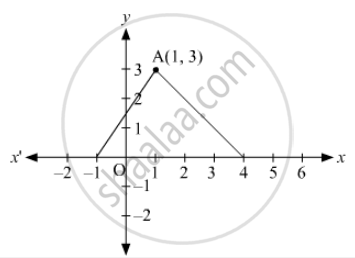Advertisements
Advertisements
Question
The coordinates of the fourth vertex of the rectangle formed by the points (0, 0), (2, 0), (0, 3) are
Options
(3, 0)
(0, 2)
(2, 3)
(3, 2)
Solution
We have to find the co-ordinates of forth vertex of the rectangle ABCD.
We the co-ordinates of the vertices as (0, 0); (2, 0); (0, 3)
Rectangle has opposite pair of sides equal.
When we plot the given co-ordinates of the vertices on a Cartesian plane, we observe that the length and width of the rectangle is 2 and 3 units respectively.
So the co-ordinate of the forth vertex is( 2 , 3)
APPEARS IN
RELATED QUESTIONS
Which point on the x-axis is equidistant from (5, 9) and (−4, 6)?
If three consecutive vertices of a parallelogram are (1, -2), (3, 6) and (5, 10), find its fourth vertex.
If A and B are (1, 4) and (5, 2) respectively, find the coordinates of P when AP/BP = 3/4.
If the point A (4,3) and B ( x,5) lies on a circle with the centre o (2,3) . Find the value of x.
Mark the correct alternative in each of the following:
The point of intersect of the coordinate axes is
If A(3, y) is equidistant from points P(8, −3) and Q(7, 6), find the value of y and find the distance AQ.
If (a,b) is the mid-point of the line segment joining the points A (10, - 6) , B (k,4) and a - 2b = 18 , find the value of k and the distance AB.
If the point P (m, 3) lies on the line segment joining the points \[A\left( - \frac{2}{5}, 6 \right)\] and B (2, 8), find the value of m.
Write the coordinates the reflections of points (3, 5) in X and Y -axes.
Find the distance between the points \[\left( - \frac{8}{5}, 2 \right)\] and \[\left( \frac{2}{5}, 2 \right)\] .
If (−1, 2), (2, −1) and (3, 1) are any three vertices of a parallelogram, then
If the centroid of the triangle formed by the points (a, b), (b, c) and (c, a) is at the origin, then a3 + b3 + c3 =
In Fig. 14.46, the area of ΔABC (in square units) is

The line segment joining the points A(2, 1) and B (5, - 8) is trisected at the points P and Q such that P is nearer to A. If P also lies on the line given by 2x - y + k= 0 find the value of k.
Point (–10, 0) lies ______.
Which of the points P(0, 3), Q(1, 0), R(0, –1), S(–5, 0), T(1, 2) do not lie on the x-axis?
If the coordinate of point A on the number line is –1 and that of point B is 6, then find d(A, B).
In which ratio the y-axis divides the line segment joining the points (5, – 6) and (–1, – 4)?
Co-ordinates of origin are ______.
The distance of the point (–4, 3) from y-axis is ______.
